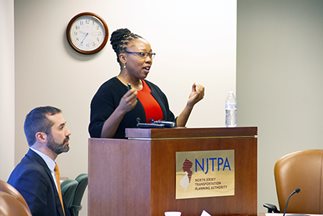 Streets are routinely redesigned to improve the safety of drivers, people walking and cyclists. But what about using designs to improve safety by reducing crime? Good lighting, landscaping, well-designed sidewalks and public spaces can all make a community feel safer, according to a panel of speakers at the Together North Jersey Institute’s last workshop on Crime Prevention Through Environmental Design (CPTED).
Streets are routinely redesigned to improve the safety of drivers, people walking and cyclists. But what about using designs to improve safety by reducing crime? Good lighting, landscaping, well-designed sidewalks and public spaces can all make a community feel safer, according to a panel of speakers at the Together North Jersey Institute’s last workshop on Crime Prevention Through Environmental Design (CPTED).
CPTED brings together different stakeholders — residents, business owners, law enforcement, planners and engineers — to consider how an area’s physical features can be improved to deter crime.
Trimming trees along a street so that it’s easier to see suspicious activity, is one small step a community can take to encourage natural surveillance, which can improve safety, said Ifeoma Ebo, of the New York City Office of Criminal Justice. Another step is creating well-maintained public spaces that will attract more people and to consider using cameras to deter criminal activity.
“The more eyes that you have observing the more cameras you have observing the less opportunity there is for crime to occur,” she said.
She also said that CPTED can help build important relationships, but bringing together community members and local law enforcement to tackle problems together.
Ebo and several other speakers said that in order for CPTED to be successful it must start at the community level, rather than a local government or organization coming in and telling the community to change.
Getting community members involved in the projects also encourages them to take ownership of the redesigned spaces, said Dave Lustberg, of Arterial Consultants, who developed a CPTED plan for the City of Paterson.
“It can’t be done for or to the neighborhood,” he said. “It’s really something that has to be driven by the community.”
Pamela Daniels of the United Vailsburg Services Organization spoke about a CPTED effort on Pine Grove Terrace in Newark. There is an alley behind the homes on Pine Grove Terrace and Alexander Street, known as The Lane or Alexander Alley, which has become a dumping ground for trash and a place where crime occurs. Residents suggested splitting the property up and adding it to the adjoining lots, however that area has a high number of vacant and abandoned properties, Daniels said.
So the group worked with graduate students at the Bloustein School of Planning and Public Policy at Rutgers and came up with two other concepts. One would create a bike lane and tie in a local bike shop to teach people about maintenance and repairs. Another would transform the alley into a public meeting space with a community garden and a café. The students also proposed plans for improving Pine Grove Avenue, which is wide for a one-way street and has some safety concerns.
Daniels said the group is now working to build support for one of the options and raise funds to make it a reality. In the spring they will conduct a demonstration project, which includes temporarily bumping out the curbs, to slow traffic and show the community what potential safety improvements could look like. They are also planning a farm-to-table community dinner in The Lane so that people can envision the space’s potential.